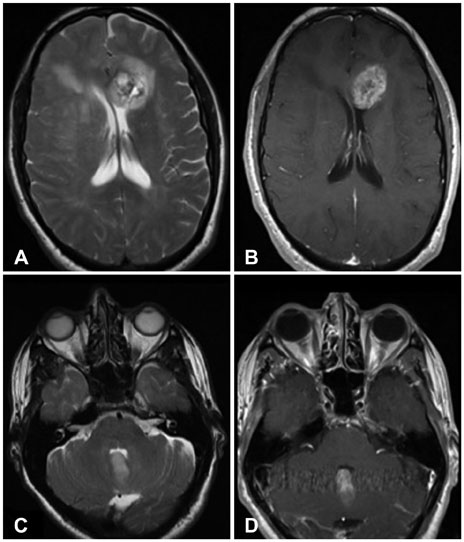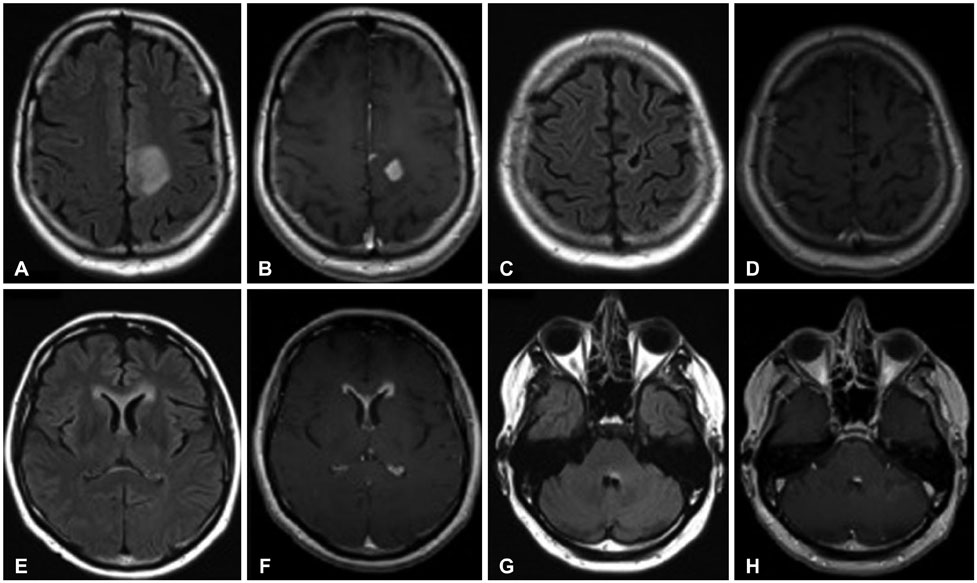Brain Tumor Res Treat.
2017 Apr;5(1):24-29. 10.14791/btrt.2017.5.1.24.
Fourth Ventricular Lesions in Metastatic Gliomas: A Rare Predilection?
- Affiliations
-
- 1Department of Radiology, University of Manitoba, Winnipeg, Canada. nazirkhanmd@gmail.com
- 2Department of Radiology, Laval University, Quebec, Canada.
- KMID: 2378301
- DOI: http://doi.org/10.14791/btrt.2017.5.1.24
Abstract
- Over the course of five years, a total of ten cases were collected of glioma patients in whom a distant lesion at the fourth ventricle was noted. A "˜distant lesion' was defined as a lesion with a normal appearing tissue bridge at imaging between the primary and secondary locations. Previous imaging of these patients was reviewed along with clinical history, course of therapy, and available histology. A review of the literature was performed with respect to present knowledge on patterns of glioma proliferation and dissemination. This case series is the first to describe the fourth ventricle as a location that may be prone to secondary lesions in glioma patients. Further investigation on this subject may yield deeper insights into the mechanisms by which glial tumors spread within the brain, with the hope of developing or improving therapeutic targets.
Keyword
MeSH Terms
Figure
Reference
-
1. Louis DN, Ohgaki H, Wiestler OD, Cavenee WK. WHO classification of tumours of the central nervous system. Revised 4th ed. Lyon: International Agency for Research on Cancer;2016. p. 10–122.2. Jezewski D, Parafiniuk D, Nowacki P, Kojder I. Intracerebral metastasis of glioblastoma multiforme. Case report and literature review. Ann Acad Med Stetin. 2011; 57:59–63. discussion 63-4.3. Satter MR, Henry PT, Khan AI, Chowdhury Q, Hossain M, Kundu RK. Supratentorial glioblastoma multiforme metastasizing to the cervical spinal cord. Mymensingh Med J. 2014; 23:806–810.4. Shahideh M, Fallah A, Munoz DG, Loch Macdonald R. Systematic review of primary intracranial glioblastoma multiforme with symptomatic spinal metastases, with two illustrative patients. J Clin Neurosci. 2012; 19:1080–1086.
Article5. Louis DN, Ohgaki H, Wiestler OD, Cavenee WK. WHO classification of tumours of the central nervous system. 4th ed. Lyon: International Agency for Research on Cancer;2007. p. 8–93.6. Hygino da Cruz LC Jr, Kimura M. Neuroimaging and genetic influence in treating brain neoplasms. Neuroimaging Clin N Am. 2015; 25:121–140.
Article7. Lawton CD, Nagasawa DT, Yang I, Fessler RG, Smith ZA. Leptomeningeal spinal metastases from glioblastoma multiforme: treatment and management of an uncommon manifestation of disease. J Neurosurg Spine. 2012; 17:438–448.
Article8. Cage TA, Pekmezci M, Prados M, Berger MS. Subependymal spread of recurrent glioblastoma detected with the intraoperative use of 5-aminolevulinic acid: case report. J Neurosurg. 2013; 118:1220–1223.
Article9. Goryaynov SA, Potapov AA, Ignatenko MA, et al. [Glioblastoma metastases: a literature review and a description of six clinical observations]. Zh Vopr Neirokhir Im N N Burdenko. 2015; 79:33–43.
Article10. Peretto P, Merighi A, Fasolo A, Bonfanti L. The subependymal layer in rodents: a site of structural plasticity and cell migration in the adult mammalian brain. Brain Res Bull. 1999; 49:221–243.
Article11. Lim DA, Cha S, Mayo MC, et al. Relationship of glioblastoma multiforme to neural stem cell regions predicts invasive and multifocal tumor phenotype. Neuro Oncol. 2007; 9:424–429.
Article12. Hladky SB, Barrand MA. Mechanisms of fluid movement into, through and out of the brain: evaluation of the evidence. Fluids Barriers CNS. 2014; 11:26.
Article13. Louveau A, Smirnov I, Keyes TJ, et al. Structural and functional features of central nervous system lymphatic vessels. Nature. 2015; 523:337–341.
Article14. Nedergaard M. Neuroscience. Garbage truck of the brain. Science. 2013; 340:1529–1530.
- Full Text Links
- Actions
-
Cited
- CITED
-
- Close
- Share
- Similar articles
-
- Glioma Immunotherapy: Advances and Challenges for Spinal Cord Gliomas
- Experiences of ventriculography using methylglucamine iothalamate 60%(Conray)
- Various Tumors in the 4th Ventricle in Adults: MRI Findings
- Clinical Features and Predilection Sites of the Lesions Observed in Chronic Cutaneous Lupus Erythematosus
- Expression of Trans forming Growth Factor-a and Proliferating Cell Nuclear Antigen in Human Gliomas






